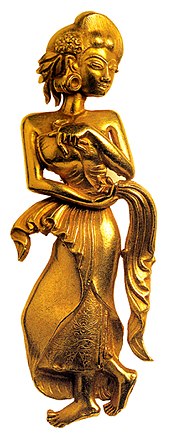Golden age

The graceful Bidadari Majapahit, golden celestial apsara in Majapahit style perfectly describes Majapahit as "the golden age" of the archipelago.
Next to launching naval and military expeditions, the expansion of Majapahit Empire also involved diplomacy and alliance. Hayam Wuruk decided, probably for political reasons, to take princess Citra Rashmi (Pitaloka) of neighboring Sunda Kingdom as his consort.[15] The Sundanese took this proposal as an alliance agreement. In 1357 the Sunda king and his royal family came to Majapahit, to accompany and marry his daughter with Hayam Wuruk. However Gajah Mada saw this event as an opportunity to demand Sunda's submission to Majapahit overlordship. The skirmish between the Sunda royal family and the Majapahit troops on Bubat square were unevitable. Despite the courageous resistance, the royal family were overwhelmed and decimated. Almost whole of the Sundanese royal party were viciously massacred.[16] Tradition mentioned that the heartbroken Princess committed suicide to defend the honour of her country.[17] The Battle of Bubat or Pasunda Bubat tragedy become the main theme of Kidung Sunda, also mentioned in Carita Parahyangan and Pararaton, however it was never mentioned in Nagarakretagama.
The Nagarakertagama, written in 1365 depict a sophisticated court with refined taste in art and literature, and a complex system of religious rituals. The poet describes Majapahit as the centre of a huge mandala extending from New Guinea and Maluku to Sumatra and Malay Peninsula. Local traditions in many parts of Indonesia retain accounts in more or less legendary form from 14th century Majapahit's power. Majapahit's direct administration did not extend beyond east Java and Bali, but challenges to Majapahit's claim to overlordship in outer islands drew forceful responses.[18]
In 1377, a few years after Gajah Mada's death, Majapahit sent a punitive naval attack against a rebellion in Palembang,[4] contributing to the end of the Srivijayan kingdom. Gajah Mada's other renowned general was Adityawarman[citation needed], known for his conquest in Minangkabau.
The nature of the Majapahit empire and its extent is subject to debate. It may have had limited or entirely notional influence over some of the tributary states in included Sumatra, the Malay Peninsula, Kalimantan and eastern Indonesia over which of authority was claimed in the Nagarakertagama.[19] Geographical and economic constraints suggest that rather than a regular centralised authority, the outer states were most likely to have been connected mainly by trade connections, which was probably a royal monopoly.[4] It also claimed relationships with Champa, Cambodia, Siam, southern Burma, and Vietnam, and even sent missions to China.[4]
Although the Majapahit rulers extended their power over other islands and destroyed neighboring kingdoms, their focus seems to have been on controlling and gaining a larger share of the commercial trade that passed through the archipelago. About the time Majapahit was founded, Muslim traders and proselytizers began entering the area.


Tidak ada komentar:
Posting Komentar